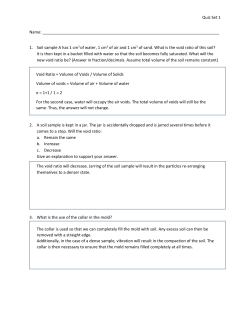
Soil pH Submission Form—Homeowners
Fee: $5.00 per Sample (5 or more $3.50 per sample) Soil pH Submission Form—Homeowners Make checks payable to Cornell Cooperative Extension—Suffolk County Date ______________________ Name ___________________________________________________________________________ Phone ( ) _______________ Office Use Only # of Samples _______ Amount Paid _______ CCE Staff _______ Address _________________________________________________________________________ Send report via email (Print Legibly) City _______________________________________________ State ____ Zip _____________ ________________________________________________ Instructions For Taking Soil Samples Are Given On The Back Of This Sheet Did you submit a plant/lawn sample(s) also? YES NO This Side To Be Filled In By Customer (Refer to instructions on the back of this sheet) Sample Identification Plant(s) Growing Here (Refer to the instructions for sample identifiNo. cation on the back of this sheet) (List only the primary plant(s) - refer to the instructions on the back of this sheet) This Side For Office Use Only pH CaCl2 EC µS/cm EC mS/cm S A N L O S S A L L O M S I L 1. 2. 3. 4. 5. 6. 7. 8. 9. 10. Use this space to provide more information: _____________________________________________________________________________________________ Cornell Cooperative Extension in Suffolk County provides equal program and employment opportunities. Instructions For Taking A Soil Sample & Filling Out The Data Form 1. Instructions for taking a soil sample: First determine how many samples to take. Different gardens/ beds, lawns, areas with different soil types, areas where amendments such as limestone were added, areas with plants having different pH requirements, good/bad areas, etc. should be sampled separately. In gardens/new plantings where the soil will be turned under/rototilled individual samples are taken from the upper 6 to 8 inches of soil. In established plantings or lawns where the soil will not be turned under individual samples are taken from the upper 3 inches of soil. Each soil sample is comprised of 5 to 10 individual samples obtained by walking back and forth diagonally across the area to be sampled. Use a trowel to dig a small hole to the desired depth. Remove a slice of soil from the entire side of the hole and place this in a clean plastic container. Repeat this procedure at each of the 5 to 10 random spots and place the soil from these spots in the same container. Remove stones, grass, etc. Next remove two 8 ounce cupfuls of the soil in the container and place this in a plastic bag. Secure the bag. This is your soil sample for that area. Mark the outside of the bag with an identification (i.e. #1, #2, or ―A‖, ―B‖, or ―East‖, ―West‖). Keep the identification simple. Repeat this entire procedure for each additional garden, landscape bed, lawn, etc. 2. Instructions for filling in data form on front page: Fill in your name, mailing address, today’s date, phone number and email address if you want your report sent via email. You must write legibly. Under the column marked “Sample Identification” enter the identification marked on the outside of the bag. Under the column marked “Plant(s) Growing Here” write the primary plant(s) that grow in the area you sampled. Do not list all of the plants growing in a particular area. For instance if the sample is taken from a lawn—then list lawn and not all the trees growing in the lawn. Do not list all of the vegetables or flowers growing in a garden– but rather list vegetable garden, or perennial flowers, or annual flowers, etc., which is the primary plant that you want a recommendation to be based on. It would be important to note plants that require acid soil conditions—some common plants that require acid soil are: rhododendron, azalea, mountain laurel, Pieris (andromeda), holly, pin oak, blueberries, leucothoe, and inkberry. If the area has not yet been planted do not list things like weeds, crabgrass, etc.—indicate the primary plant(s) that will be seeded or planted. Use a separate piece of paper if you need to provide more information. 3. Packing/Shipping Make sure each plastic bag is securely closed. Select a strong container, such as a corrugated box, that will not crush in transit. Depending on the number of samples submitted a padded shipping envelope will also work. Use a layer of appropriate packing material (i.e. Styrofoam, crushed paper, packing peanuts, etc.) on the bottom of the box. Place the bags containing the soil samples on top of this material and then fill in the space above the sample with more packing material to keep samples secure in transit. Include this completed data form with your sample . 4. Payment/Mailing Address The fee for soil pH testing is $5.00 per sample (or $3.50 per sample when submitting 5 or more samples). Payment is due when dropping off samples or should be included with samples that are shipped. The Soil Testing Lab is located at the Education Center in Riverhead. Samples should be shipped or dropped off at that office. As a convenience samples that are dropped off at the Bayard Cutting Arboretum location will be transferred to the Education Center. A drop off box is located at each office for after hours or weekends. The box is located at the rear door entrance of the Education Center. Samples are tested once or twice a week— Samples can not be tested at the time you drop them off. TK 1/2009, AW 12/2011
© Copyright 2025





















